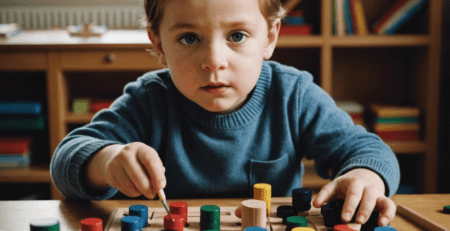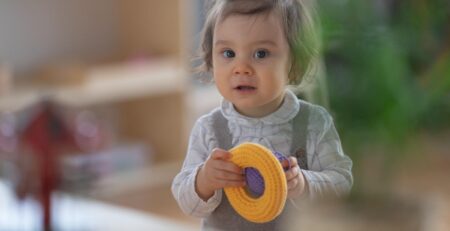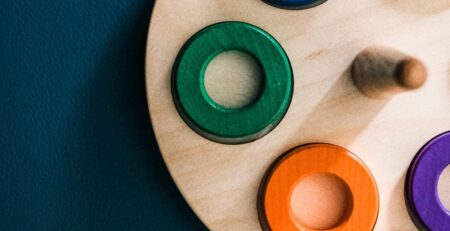
21
The Purpose of the Montessori Pink Tower: Explained
In the world of Montessori education, the pink tower stands as a striking visual centerpiece, capturing the attention of both students and educators alike. But what is the purpose of this intriguing and carefully crafted learning material? Join us as we delve into the significance and purpose of the pink tower in Montessori education, exploring its role in developing important skills and fostering a love for learning in young children. From its vibrant hue to its meticulous construction, the pink tower holds a key place in the Montessori classroom, contributing to a rich and engaging educational experience for students. Let’s unpack the mystery and discover the true purpose of this beloved Montessori tool.
Table of Contents
- Introduction
- About the Montessori Pink Tower
- Purpose of the Pink Tower in Montessori
- Benefits of Using the Pink Tower
- How the Pink Tower Supports Child Development
- Q&A
- The Way Forward
Introduction
Welcome to our comprehensive guide on the purpose of the Pink Tower in Montessori education. The Pink Tower is a fundamental material in the Montessori classroom, designed to serve a specific purpose in the development of young children. In this article, we will explore the significance of the Pink Tower and its role in aiding children’s cognitive and physical growth.
As Maria Montessori, the founder of the Montessori method, believed in hands-on learning and sensory experiences as crucial elements in education, the Pink Tower is an essential component in creating an environment that supports these principles. Let’s dive into the world of Montessori education and uncover the purpose behind the iconic Pink Tower.
What Makes the Pink Tower Special?
The Pink Tower is a set of ten wooden cubes varying in size from 1 cubic centimeter to 10 cubic centimeters, each painted pink. This distinctive material is designed to capture the attention of young children and serves as a tool for them to explore size, dimension, and spatial relationships in a tangible and interactive way. Let’s break down the specific purposes the Pink Tower serves in the Montessori classroom:
- Developing Visual Discrimination: The Pink Tower allows children to visually compare and contrast the sizes of the cubes, honing their ability to discriminate differences in dimensions.
- Refining Motor Skills: As children carefully handle and stack the cubes, they refine their fine motor skills and hand-eye coordination, laying a strong foundation for future practical tasks.
- Internalizing Math Concepts: By working with the Pink Tower, children unconsciously internalize concepts of size, proportion, and volume, providing a precursor to more advanced mathematical ideas.
Understanding the purpose of the Pink Tower in Montessori education allows educators and parents to appreciate its value in the holistic development of children, making it a vital element of the carefully crafted Montessori curriculum.
About the Montessori Pink Tower
The Montessori Pink Tower is a unique and essential element of the Montessori educational philosophy. It is not just a regular toy to keep kids engaged, but it serves a number of important educational purposes. The primary purpose of the Pink Tower is to help children develop their visual discrimination skills, as well as their hand-eye coordination. This is achieved through the process of stacking the various pink cubes in order from largest to smallest, allowing children to visually compare the sizes and develop an understanding of spatial relationships.
Additionally, the Pink Tower also aids in the development of math concepts such as volume, as children can see and feel the differences in the sizes of the cubes. This hands-on experience allows them to internalize mathematical concepts in a concrete way which is crucial for their understanding and retention of the material. With regular use of the Pink Tower, children also develop their concentration and focus, as they are encouraged to work carefully and with precision to achieve the goal of stacking the cubes in the correct order.
The Pink Tower is not merely a tool for education, but an integral part of the Montessori approach to learning. It provides children with a sensory experience that engages their mind and body, allowing them to learn and explore in a tactile and immersive manner. Through the use of the Pink Tower, children develop important foundational skills that will serve them well throughout their educational journey and beyond.
Purpose of the Pink Tower in Montessori
When it comes to Montessori education, the pink tower is an essential material used in the classroom. But what exactly is the education? Let’s delve into the significance of this iconic tool and its role in the development of young children.
Developing Visual Discrimination
The pink tower is designed to help children refine their visual discrimination skills. The tower consists of ten pink cubes of varying sizes, allowing children to practice arranging the cubes from largest to smallest. Through this activity, children develop their ability to visually discriminate between different sizes, thereby honing their spatial awareness and perception. This fundamental skill lays the groundwork for future mathematical and geometric understanding, making the pink tower an invaluable tool in the Montessori classroom.
Refining Fine Motor Skills
In addition to its role in visual discrimination, the pink tower also aids in the development of fine motor skills. As children manipulate the cubes and carefully stack them in the correct sequence, they are refining their hand-eye coordination and dexterity. These fine motor skills are essential for activities such as writing, drawing, and other tasks that require precision and control. By engaging with the pink tower, children are not only refining their visual perception but also laying the foundation for future academic success.
Enhancing Concentration and Focus
Another important education is its ability to enhance children’s concentration and focus. As they work with the cubes, children are encouraged to concentrate on the task at hand, carefully observing the differences in size and arranging the cubes accordingly. This focused attention helps children develop their ability to concentrate for extended periods, a skill that is crucial for academic achievement and overall cognitive development.
The pink tower in Montessori education serves multiple important purposes, from developing visual discrimination and fine motor skills to enhancing concentration and focus. By incorporating the pink tower into the classroom environment, Montessori educators are providing children with a valuable tool for holistic development.
Benefits of Using the Pink Tower
One of the foundational materials in Montessori education is the Pink Tower, which serves as an essential tool in helping young children develop their spatial awareness, fine motor skills, and sense of order. This iconic Montessori material comes with a range of benefits for young learners, and its use has been shown to have a positive impact on child development. Let’s explore some of the key advantages of incorporating the Pink Tower into the learning environment.
1. Develops Spatial Awareness: The Pink Tower is designed to help children understand spatial relationships and dimensions. By stacking the ten wooden cubes from largest to smallest, children develop a sense of visual discrimination and learn to differentiate between varying sizes. This process helps to lay a strong foundation for geometry and spatial reasoning skills, which are crucial for cognitive development.
2. Enhances Fine Motor Skills: Manipulating the wooden cubes of the Pink Tower requires precision and control, promoting the development of fine motor skills in young children. As they carefully handle and stack the cubes, children refine their hand-eye coordination and dexterity. These skills are essential for everyday tasks such as writing, drawing, and using tools, making the Pink Tower an invaluable tool for early childhood development.
3. Fosters Sense of Order and Concentration: The orderly arrangement of the Pink Tower cubes encourages children to work systematically, fostering a sense of order and concentration. Through repetition and refinement, children develop an internal sense of structure and organization, which can positively impact their ability to focus and complete tasks. This aspect of the Pink Tower aligns with the Montessori philosophy of nurturing independence and self-discipline in young learners.
Incorporating the Pink Tower into the Montessori classroom or home environment offers a wealth of benefits for young children, supporting their cognitive, physical, and emotional development. By providing children with the opportunity to engage with this foundational material, educators and parents can contribute to the holistic growth of the child, laying the groundwork for future learning and academic success.
How the Pink Tower Supports Child Development
As an essential component of the Montessori education method, the Pink Tower plays a crucial role in supporting a child’s overall development. This iconic material not only helps children build their motor skills, but also fosters important cognitive and sensory development. Let’s take a closer look at how the pink tower supports child development.
Motors Skill Development
- Size Grading: The Pink Tower consists of ten pink wooden cubes of varying sizes. When children stack these cubes from largest to smallest, they are refining their fine motor skills and hand-eye coordination.
- Precision and Balance: As children carefully place each cube on top of the other, they are honing their ability to control and coordinate their movements with precision and accuracy.
Sensory and Cognitive Development
- Visual Discrimination: By observing and handling the differently sized cubes, children develop their ability to distinguish between various dimensions, enhancing their visual discrimination skills.
- Problem-Solving Skills: As they experiment with different combinations and arrangements of the cubes, children engage in critical thinking and problem-solving, laying the groundwork for future academic success.
- Sensory Exploration: The tactile experience of handling the smooth wooden cubes provides a sensory-rich environment, stimulating the child’s sense of touch and enhancing their overall sensory development.
the Pink Tower is a multifaceted learning tool that supports not only physical and motor skill development, but also cognitive and sensory growth. Its presence in the Montessori classroom is instrumental in nurturing well-rounded, independent learners.
Q&A
Q: What is the purpose of the pink tower in Montessori education?
A: The pink tower is a fundamental material in Montessori education, serving multiple purposes in a child’s development.
Q: How does the pink tower benefit a child’s learning?
A: The pink tower helps children develop their visual discrimination, coordination, and concentration skills. It also introduces them to the concept of size and dimension.
Q: What age group is the pink tower targeted towards?
A: The pink tower is typically introduced to children in the early years of Montessori education, around the ages of 3 to 4.
Q: What are the educational goals associated with the pink tower?
A: The pink tower aims to enhance a child’s fine motor skills, spatial awareness, and ability to visually compare and contrast objects.
Q: How does the pink tower fit into the Montessori philosophy?
A: The pink tower aligns with the Montessori philosophy by promoting hands-on, self-directed learning that encourages children to explore and discover at their own pace.
Q: Can the pink tower be used for collaborative learning?
A: While the pink tower is primarily an individual work, it can also be used as a tool for cooperative play and peer interaction, facilitating social development.
Q: Are there variations of the pink tower used in Montessori education?
A: Yes, there are variations of the pink tower that incorporate different color schemes or materials to provide children with a broader sensory experience.
Q: How does the pink tower contribute to a child’s overall development?
A: The pink tower promotes cognitive, physical, and social development, laying the foundation for future academic and life skills in a Montessori environment.
The Way Forward
The pink tower in Montessori serves several important purposes in the development of young children. It not only aids in the refinement of fine motor skills and hand-eye coordination, but also helps foster an understanding of mathematical concepts such as size, dimension, and spatial relationships. The tower is not just a simple set of wooden blocks, but a meticulously designed educational tool that encourages independent learning and exploration. As such, it plays a crucial role in the Montessori approach to early childhood education, and continues to inspire and engage young minds around the world. With its timeless appeal and enduring educational value, the pink tower remains an integral part of the Montessori classroom, enriching the learning experiences of children for generations to come.










